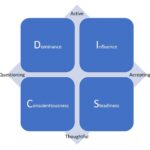Sales are the lifeblood of every small business, yet few businesses invest the time and energy to create a business development plan. A business development plan includes a target client profile to know where to focus its client acquisition energies. Moreover, few small businesses assess who the actual decision influencers are among their best clients. This step is necessary as if you know where the decision influencers spend their time, it is likely many more of them that will meet your target client profile so you can replicate your success with your best customers.
Most small businesses are started by technicians who have minimal sales experience and therefore do not think like salespeople. As a result, when it comes to sales, they shoot from the hip and do not have a strategy to acquire a specific type of customer. Instead, they cast a wide net and hope to capture any client willing to pay. Most small businesses are happy with any sale. Unfortunately, finding their next best client will be a crapshoot if they don’t have a specific target client profile and don’t understand how key decision influencers, who meet their profile, spend their time.
The process of achieving greater sales should not be left to chance and involves three steps:
- Create a Target Client Profile
- Identify the Key Decision Influencers in a Target Client
- Have an “If You Were Me” discovery call With Decision Influencers
This three-step business development strategy will net you incredibly vital information that you can use to acquire more profitable clients.
Target Client Profile
Many businesses struggle to identify the attributes that define their BEST customers. As a result, they take on clients that are not ideal and are often forced to compete on price, squeezing margins and sucking the life out of the enterprise.
Your biggest customer is often not your best customer. They often ask for price concessions because they know you can’t afford to lose them as a client since losing them would create a significant cash flow hit to your business.
So, what is the profile that describes your best customer? Lee Salz, in his book, Sell Different! recommends that you list the target customer profile based on the following nine criteria.
Size: Size can be measured in terms of units, revenue, number of employees, number of locations, number of hires, growth rate, etc. At SteveBizBlog, we focus on micro-business with less than ten employees, with one location, generally in their early stages.
Location: Where is your brand the strongest? What is a growth area for you? Where are their most influential decision influencers located? How do their field locations align with yours? At SteveBizBlog, we have a strong following in Colorado Springs, where we have our headquarters and are plugged into entrepreneurial ecosystems, but our reach is global.
Business Type: For which NAICS code or industry are you best suited to provide solutions? Are they private or publicly traded businesses or home-based businesses? Are they venture capital-backed? Are your best customers other businesses, consumers, or government agencies? At SteveBizBlog, we focus on private service-based businesses since they require less capital to start and avoid the Business-to-Government (B2G) sector.
Incumbent: Do they have a current provider? Does their provider have an inferior or incomplete solution? Are they looking for a provider to deliver a complete solution or augment an existing solution? Is the deliverable managed internally, or is it an outsourced function? At SteveBizBlog, we want to be our client’s first general business advisor and welcome helping our clients coordinate their efforts with consultants who have critical and more focused domain knowledge.
Circumstances and Goals: Define your best target client in terms of the following five circumstances and goals by completing the question “Our best client:”
- Has issues with…
- Has a desire to…
- Has challenges with…
- Has compliance priorities, including…
- Has management initiatives, including…
At SteveBizBlog, our best client:
- Has issues with finding the right information for a business at their stage that is not confusing.
- Has a desire to start and operate a successful small business.
- Has challenges with being overwhelmed with too much data that is not relevant to their current business situation or hard to understand.
- Has compliance priorities, including ensuring they have all the proper licensing and following all government-mandated policies.
- Has management initiatives, including being able to effectively manage their time, human, and capital resources so they can make a profit.
Decision Drivers: Decision drivers represent anything that will lead them to be receptive to a conversation about what you have to offer. Is a new executive looking to make changes? Have they just gone through an acquisition, expansion, relocation, or consolidation? Are they launching a new product line? Are they going through a workforce reduction or expansion? Are they responding to a fine, lawsuit, or regulatory changes? At SteveBizBlog, we focus on newly minted entrepreneurs who are looking to start their first business and don’t have a business mentor to help them on their journey.
Corporate Attributes: What is their financial health? Do they have a specific organizational structure or company culture? At SteveBizBlog, our clients have limited funds and are looking for free or low-cost solutions to start and operate their business until they reach profitability.
Buying Process: How do they buy? Who is involved in the decision-making process? Who is driving the decision? Are they an active buyer already on their journey to make a purchase, or are they a passive buyer who has yet to begin?
Deal Breakers: Deal breakers have qualities opposite to what you want in a target client and represent aspects that indicate this is not the right client to pursue. For example, are they slow payers? Have they a lousy PR reputation? Are they not located in a desirable geographical area?
Identify Key Decision Influencers
Once you have a well-thought-out target client profile, review your book of clients because the next step is to interview key decision influencers that match your target client profile.
Choosing the highest level of decision influencer should not be taken too lightly. The decision influencer may not be your point person. Often, key decision influencers hide behind the curtain.
B2B Decision Influencers
Business-to-Business (B2B) sales are what I consider complex sales. Complex sales involve three or more distinct people in a company, each with different requirements.
First, there is the money guy (The Payer) who controls the purse strings. The money guy is interested in Return on Investment (ROI) and profits.
Then, there is the purchasing department guy (The Buyer) who acts as the gatekeeper and whose job it is to keep you out. Purchasing is interested in the amount of insurance or bonding you have and your past performance.
Finally, there is the technical guy (The User) or the person who needs your product or service. The technical guy is interested in how your product or service can solve their problems.
Often the technical guy is the person you have the most contact with, and while they may be the highest decision influencer, this is not always the case. I have seen many situations where the money guy and the purchasing department guy were the ones pulling the strings behind the scenes. What I have found most productive in these situations is to spend some time coaching the technical guy about how to position the solution. Likely, they are not great negotiators and, therefore, may not be able to sell the solution without some help. Therefore, since the technical guy has minimal sales experience, you can often help them develop their skills to better communicate the offer.
B2C Decision Influencers
When it comes to Business-to-Consumer (B2C), the decision influencer is likely the person you interacted with the most and asked the most questions.
Recently, we did a kitchen remodel. Since the kitchen in our household is the domain of my wife, she was the person that made the initial contact with the general contractor and the various vendors and provided them with her wish list of items. It would be easy to identify her as the decision influencer. Although my wife remained the reference person for some subcontractors, such as the electrician and the cabinetmaker, I was the one behind the scenes crafting emails from our family email account with detailed questions and commenting on their plans. The savvy business person would recognize the clues in the emails that would identify me as the author, even though my wife was identified as the point person. No decision was made unless I was convinced and onboard. However, some subcontractors failed to identify me as the key decision influencer behind the scenes until it was too late, and they lost the bid.
“If You Were Me” Discovery Call
Once you have identified a key decision inference representing your target client profile, schedule an in-person “If you were me” discovery call to find out where to find other decision influencers like them. The conversation might sound something like the following:
“Since you have been a client of ours for many years, you are well aware of what we offer and the quality of our offering. May I ask you a question? If you were me:
- What associations would you be involved in to meet more people like you?
- What conferences would you attend to meet more people like you?
- What events would you go to to meet more people like you?
- What would you read to meet more people like you?
You are NOT asking for referrals or references at this meeting, and you are not up-selling or cross-selling. You are not asking the decision influencer where they spend their time, as they may not have the budget, but rather where would they spend more time if they were you to meet more customers like them. Asking them for their advice and stating you want to meet more clients like them stokes their ego and makes them feel important.
This strategy works not only for B2B clients but also for B2C clients. B2C clients may suggest neighborhood meetings or community events that they recommend you attend or newsletters you should subscribe to.
According to Lee, you will be surprised at how forthcoming your clients are to provide you with information that you can use to improve your future sales efforts. Without asking these questions, your only option is to guess. People by nature want to help, but they don’t often volunteer, and sometimes you just have to ask.
Sales should not be something you do without a clear plan to attract the best kind of clients. Following the business development strategy described above will give you the information you need to duplicate your best clients.
Do you have a business development plan to attract your best clients?












